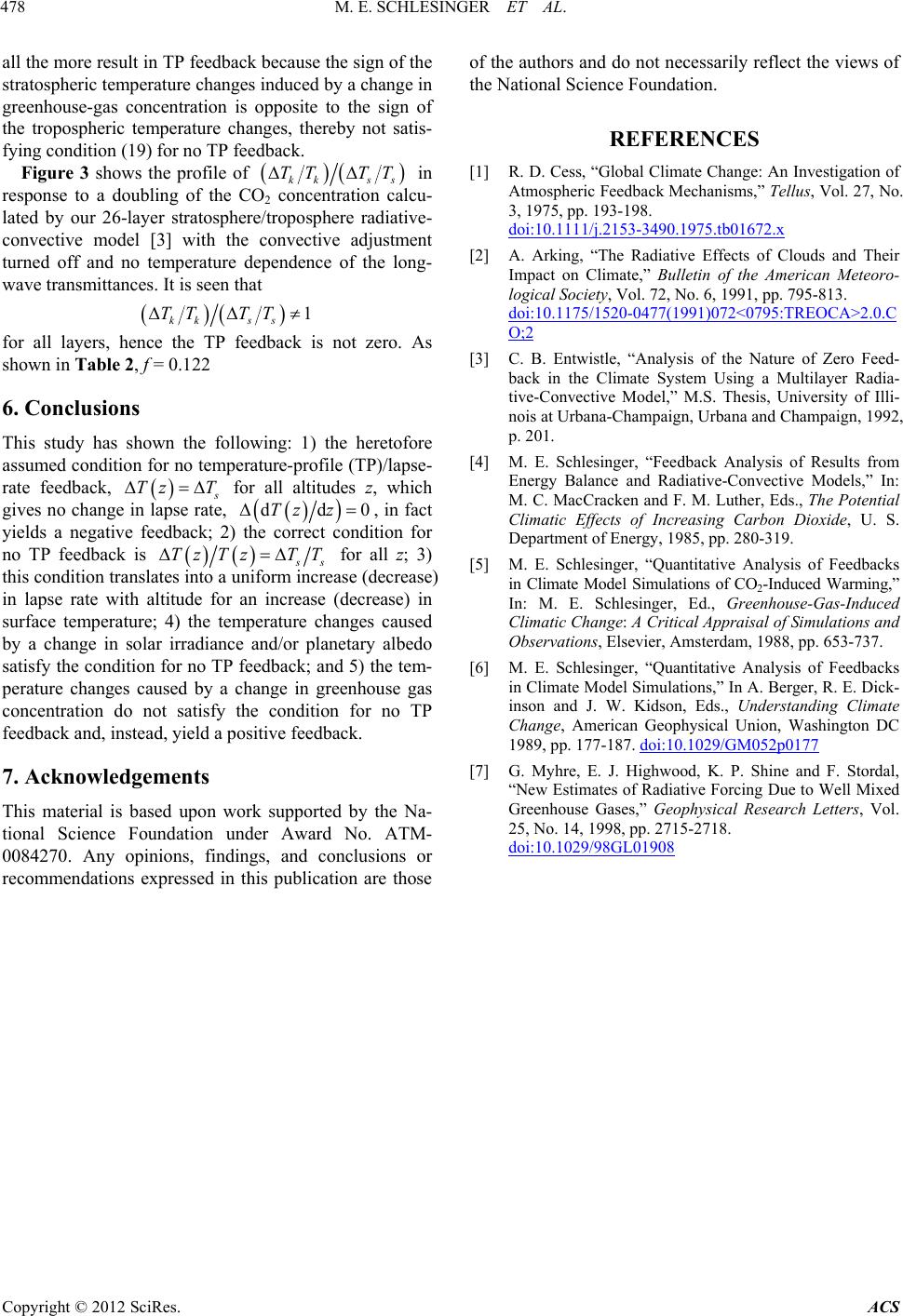
M. E. SCHLESINGER ET AL.
Copyright © 2012 SciRes. ACS
478
all the more result in TP feedback because the sign of the
stratospheric temperature changes induced by a change in
greenhouse-gas concentration is opposite to the sign of
the tropospheric temperature changes, thereby not satis-
fying condition (19) for no TP feedback.
Figure 3 shows the profile of
kk ss
in
response to a doubling of the CO2 concentration calcu-
lated by our 26-layer stratosphere/troposphere radiative-
convective model [3] with the convective adjustment
turned off and no temperature dependence of the long-
wave transmittances. It is seen that
TT TT
1
ss
TT
kk
TT
for all layers, hence the TP feedback is not zero. As
shown in Table 2, f = 0.122
6. Conclusions
This study has shown the following: 1) the heretofore
assumed condition for no temperature-profile (TP)/lapse-
rate feedback,
Tz T
for all altitudes z, which
gives no change in lapse rate,
dd0Tz z
, in fact
yields a negative feedback; 2) the correct condition for
no TP feedback is
s for all z; 3)
this condition translates into a uniform increase (decrease)
in lapse rate with altitude for an increase (decrease) in
surface temperature; 4) the temperature changes caused
by a change in solar irradiance and/or planetary albedo
satisfy the condition for no TP feedback; and 5) the tem-
perature changes caused by a change in greenhouse gas
concentration do not satisfy the condition for no TP
feedback and, instead, yield a positive feedback.
TzTz TT
7. Acknowledgements
This material is based upon work supported by the Na-
tional Science Foundation under Award No. ATM-
0084270. Any opinions, findings, and conclusions or
recommendations expressed in this publication are those
of the authors and do not necessarily reflect the views of
the National Science Foundation.
REFERENCES
[1] R. D. Cess, “Global Climate Change: An Investigation of
Atmospheric Feedback Mechanisms,” Tellus, Vol. 27, No.
3, 1975, pp. 193-198.
doi:10.1111/j.2153-3490.1975.tb01672.x
[2] A. Arking, “The Radiative Effects of Clouds and Their
Impact on Climate,” Bulletin of the American Meteoro-
logical Society, Vol. 72, No. 6, 1991, pp. 795-813.
doi:10.1175/1520-0477(1991)072<0795:TREOCA>2.0.C
O;2
[3] C. B. Entwistle, “Analysis of the Nature of Zero Feed-
back in the Climate System Using a Multilayer Radia-
tive-Convective Model,” M.S. Thesis, University of Illi-
nois at Urbana-Champaign, Urbana and Champaign, 1992,
p. 201.
[4] M. E. Schlesinger, “Feedback Analysis of Results from
Energy Balance and Radiative-Convective Models,” In:
M. C. MacCracken and F. M. Luther, Eds., The Potential
Climatic Effects of Increasing Carbon Dioxide, U. S.
Department of Energy, 1985, pp. 280-319.
[5] M. E. Schlesinger, “Quantitative Analysis of Feedbacks
in Climate Model Simulations of CO2-Induced Warming,”
In: M. E. Schlesinger, Ed., Greenhouse-Gas-Induced
Climatic Change: A Critical Appraisal of Simulations and
Observations, Elsevier, Amsterdam, 1988, pp. 653-737.
[6] M. E. Schlesinger, “Quantitative Analysis of Feedbacks
in Climate Model Simulations,” In A. Berger, R. E. Dick-
inson and J. W. Kidson, Eds., Understanding Climate
Change, American Geophysical Union, Washington DC
1989, pp. 177-187. doi:10.1029/GM052p0177
[7] G. Myhre, E. J. Highwood, K. P. Shine and F. Stordal,
“New Estimates of Radiative Forcing Due to Well Mixed
Greenhouse Gases,” Geophysical Research Letters, Vol.
25, No. 14, 1998, pp. 2715-2718.
doi:10.1029/98GL01908